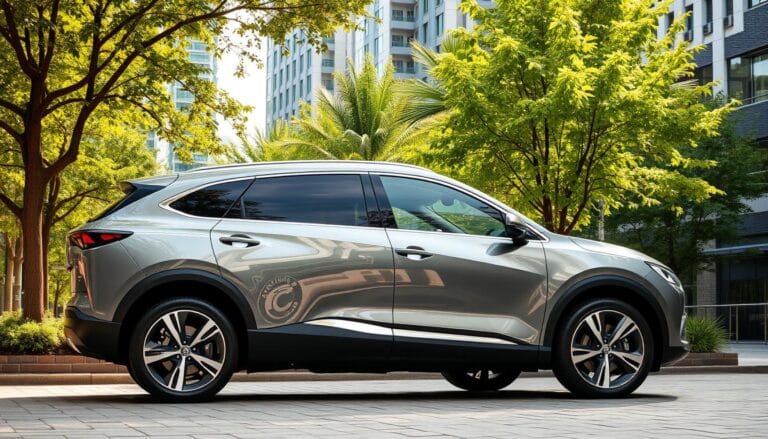Electric vehicles (EVs) are getting more popular, and people often wonder, “How long do EV batteries last?” The electric vehicle battery life is key to understanding the value and practicality of EVs. Despite being on the road for over a decade, many are still unsure about battery longevity.
A study by Recurrent looked at 15,000 electric vehicles. It found that only 1.5% had their batteries replaced, not counting major recalls. The oldest models, like the 2011-2015 Nissan LEAF and Tesla Model S, had the highest rates, around 5%. But, newer EVs from 2016 on have seen big improvements, with less than 1% needing battery replacements.
Most EVs come with warranties that cover 8-10 years or 100,000-150,000 miles. This gives owners peace of mind. Battery degradation, a natural process, happens slowly, with an average loss of 1-2% range per year. So, even after years, EV batteries still hold a lot of their original capacity.
Key Takeaways
- Only 1.5% of EVs had their batteries replaced, excluding major recalls
- Older models like the Nissan LEAF and Tesla Model S had the highest replacement rates around 5%
- Newer EVs from 2016 onwards have less than 1% battery replacement rates
- EV battery warranties typically last 8-10 years or 100,000-150,000 miles
- ev battery degradation occurs at an average rate of 1-2% range loss per year
- EV batteries retain a significant portion of their original capacity even after years of use
Understanding How Long Do EV Batteries Last
Electric vehicles (EVs) have changed the car world. They offer a cleaner and more efficient choice than traditional cars. At the center of every EV is a powerful battery pack, often made of lithium-ion batteries. These batteries are key to an EV’s performance, range, and how long it lasts.
What is an EV Battery?
EV batteries store and give out the energy needed to power the car’s electric motor. Most EVs use lithium-ion batteries because they are light, need little upkeep, and work well in hot temperatures. Over 30 years, the cost of these batteries has dropped by 97%, making EVs more affordable.
Key Components Impacting Lifespan
Several important parts affect how long an EV battery lasts. The battery management system (BMS) keeps the battery from getting too hot, too cold, or overcharged. It also helps prevent over-discharging. The thermal management system makes sure the battery stays at the right temperature, as extreme temps can harm it.
Battery capacity, measured in kilowatt-hours (kWh), is also key. As tech improves, EVs can have bigger batteries with more battery capacity. From 2012 to 2020, battery capacity has grown by 122%, leading to longer drives and less need for replacements.
| Year | Average Battery Capacity (kWh) | Increase from 2012 |
|---|---|---|
| 2012 | 20 | – |
| 2015 | 33 | 65% |
| 2020 | 44.4 | 122% |
To build trust, governments require EV makers to back their batteries with warranties. These warranties usually cover 8 years or 100,000 miles. In California, the warranty is even longer, up to 10 years or 150,000 miles. This shows how much faith manufacturers have in their EV batteries.
Factors Influencing EV Battery Longevity

The lifespan of an electric vehicle (EV) battery is key to its cost over time. The battery is the most expensive part of an EV. Several factors can affect how long an EV battery lasts, including battery temperature, charging habits, and driving conditions.
Temperature Effects
EV batteries work best when it’s between 68 to 86 degrees Fahrenheit (20-30°C). Extreme temperatures can make the battery wear out faster. High heat increases resistance, while cold can cause lithium plating, both harming the battery.
Charging Habits
How you charge your EV battery matters a lot. Overcharging or keeping it full all the time can shorten its life. EV batteries are made to last for about 1,500 to 2,000 charge/discharge cycles.
Fast charging is handy but can be hard on the battery if used too much. To keep your battery healthy, charge it between 20% and 80% and avoid keeping it at 100% for too long.
Driving Conditions
Your driving style can also affect your battery’s age. Fast starts and steep hills can reduce range and wear out the battery. But, driving smoothly and using regenerative braking can help it last longer.
Using things like climate control can also impact how well your battery works, more so in extreme weather.
| Factor | Effect on Battery Longevity |
|---|---|
| Extreme Temperatures | Accelerates degradation |
| Overcharging | Shortens battery life |
| Fast Charging | Can strain the battery if done frequently |
| Aggressive Driving | Reduces vehicle range and strains the battery |
The goal of manufacturers is to design EV batteries with recyclability in mind to provide second-life applications and recycling at the end of the vehicle-based lifespan.
Knowing what affects EV battery life helps owners take steps to make it last longer. This includes charging wisely, using advanced battery management systems (BMS), and driving smoothly.
Average EV Battery Life Expectancy
Thinking about switching to an electric vehicle? One big worry is the battery life. The good news is EV batteries are made to last a long time. They often outlast the car itself.
EV batteries are expected to last between 100,000 to 200,000 miles, or 15 to 20 years. This is way longer than a car with a gas engine, which lasts about 133,000 miles. Plus, EV batteries come with long warranties, usually 8 years or 100,000 miles. Some brands, like Hyundai, offer up to 10 years or 100,000 miles.
Typical Lifespan Across Major Brands
Every EV model has its own battery life, but most brands offer great longevity. Tesla aims for a million-mile battery and their cars last about 200,000 miles in the US. The Nissan LEAF, an early EV, has batteries lasting up to 12 years.
EV batteries do get less efficient over time, losing about 2.3% of their charge each year. But even when they’re not good for driving, they can still be used for other energy needs. They can keep about 70% of their charge.
Warranty Considerations
Car makers give EVs strong battery warranties to make buyers feel secure. Most batteries are covered for 8 years or 100,000 miles. Some brands offer even longer warranties.
| Manufacturer | Warranty Period | Battery Capacity Guarantee |
|---|---|---|
| Tesla Model 3 Standard Range | 8 years or 100,000 miles | 70% of original capacity |
| Hyundai (2020 onwards) | 10 years or 100,000 miles | 70% of original capacity |
Warranty covers battery replacements if the capacity falls below 60-70%. For EVs from 2022-2023, we’re still waiting to see big drops. Even for newer EVs from 2016 and later, battery replacements are rare. Most are covered by warranties.
Signs Your EV Battery is Deteriorating
As an electric vehicle owner, knowing the signs of a deteriorating EV battery is key. Modern EV batteries are built to last, but extreme temperatures, charging habits, and driving conditions can affect their life. By recognizing the signs of battery degradation, you can take steps to keep your EV’s battery healthy and performing well.
Decreased Range
A drop in driving range is a clear sign of battery wear. If your car goes fewer miles per charge than before, your battery’s capacity might be decreasing. EV batteries naturally lose 1-3% of their range each year. But, extreme temperatures and stressful driving can speed up this loss.
To check your battery’s health, compare its original and current capacities in kilowatt-hours (kWh). This shows how much capacity has faded. Remember, lithium-ion batteries also lose power, which can be tricky to spot without lab tests.
Strange Indicators or Alerts
Many EVs have systems that alert you when the battery health drops. Unusual warning lights or alerts on your dashboard could mean battery issues. Look out for:
- Battery warning lights
- Reduced charging speed
- Unexpected changes in battery performance
If you see these signs, get your car checked by a skilled technician. They can find the problem and fix it.
| Factor | Effect on Battery Degradation |
|---|---|
| High temperatures | Speeds up capacity loss and increases resistance |
| Extreme state of charge | Can cause lithium plating and lower capacity |
| Low temperatures | Slows reactions and raises risk of lithium plating |
| Fast charging | Creates more heat, which harms the battery |
Keeping the battery state of charge between 20% and 80% can slow down degradation.
While some range loss and minor degradation are normal, big problems are rare in modern EVs. By knowing the signs and following best charging and maintenance practices, you can make your EV battery last longer. This way, you’ll enjoy great performance for many years.
Maintenance Tips for Extending Battery Life
Proper ev battery maintenance is key for your electric vehicle’s long life and good performance. By using the right charging methods and checking your battery often, you can make your EV’s battery last longer.
Best Charging Practices
Keeping your EV battery healthy starts with good charging habits. Experts say to keep the battery between 20% and 80% charged for best results. Try to avoid letting it go below 20% or charging it too high.
Slow charging is better than fast charging. It’s less stressful on the battery. Also, park your EV in a cool, shaded spot to protect it from extreme temperatures.
If you won’t be using your EV for a while, charge it to about 50%. Then, check the charge level every few months to keep it healthy.
Regular Maintenance Checks
Regular checks are vital for catching battery problems early. Many EVs have systems that watch how you charge and use energy. This helps spot any issues before they get worse.
Technicians can also update your EV’s software during these checks. This can make your battery work better and last longer. Plus, keeping your tires properly inflated and aligned helps your EV go further and puts less strain on the battery.
| Battery Maintenance Tip | Benefit |
|---|---|
| Keep charge between 20%-80% | Prevents strain on battery |
| Use slow charging when possible | Reduces heat and stress on battery |
| Park in cool, shaded areas | Protects battery from extreme temperatures |
| Charge to 50% for long-term storage | Maintains battery health during extended periods of inactivity |
| Schedule regular maintenance checks | Identifies potential issues early on |
By following these optimal charging practices and doing regular battery health checks, you can make your EV battery last longer. Being a responsible EV owner means taking care of your battery. This not only keeps your vehicle running well but also helps the environment.
Proper EV battery maintenance is not just about extending the life of your vehicle; it’s about being a responsible consumer and contributing to a greener future.
Future Developments in EV Battery Technology
Electric vehicles (EVs) are becoming more popular, with over 10% of global sales in 2022. Experts are working hard to make EVs better. They aim to improve range, charging speed, and battery life.
One big step is solid-state batteries. These use a solid instead of liquid electrolyte. This could make EVs charge faster, last longer, and hold more energy.
Solid-State Batteries
Solid-state batteries are exciting for EVs. They could make EVs better in many ways. This includes faster charging, better safety, and longer battery life.
These batteries might last up to 20 years, much longer than current ones. As they get better, EVs will be even more appealing.
Recycling and Sustainability Efforts
More EVs mean we need to recycle batteries better. Recycling helps save the environment by reducing mining. Companies like Redwood Materials and Li-Cycle are leading this effort.
Used EV batteries can also be reused. They can store energy for homes and businesses. Tesla and Nissan are investing in recycling and reuse programs.
The EV market is growing fast. This growth is driven by government support, bans on gas cars, and more people choosing EVs. New battery tech and recycling are key to a greener future.









